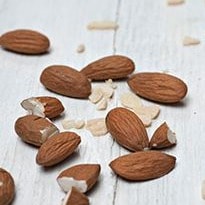Lined up alongside green, paper-skinned pistachios or buttery pecans, almonds - anaemic, lozenge-shaped, creamily bland - can seem rather dull. But they're at the heart of baking, and for good reason: the almond's mellow flavour means that it can form the foundations of frangipane, flourless cakes, macaroons, pralines and marzipan, without overpowering other ingredients or leaving the recipe unpalatably rich. The unassuming almond is a baking building block. The following recipes are just the tip of the iceberg when it comes to showcasing almond's versatility - one is a heartily savoury biscuit, the other a moist cake with seasonal rhubarb.
Black olive and almond biscuits
As far as after-dinner snacks go, you could do worse than these elegant, simple biscuits. Because the olives are blitzed to a paste, they leave the biscuits a charcoal grey colour - a smart backdrop to the flakes of toasted almond. These really are very easy to make: jKeep a close eye on them while they're in the oven: such thin biscuits burn easily. If you must serve them with something, make it a soft, mild goats' cheese, but they're delicious just as they are.
Makes 18-20
50g toasted flaked almonds, plus 2 tbsp
125g plain flour
25g parmesan, finely grated
75g cold unsalted butter, cubed
100g black kalamata olives, drained and patted dry
1 Put 50g flaked almonds into the bowl of a food processor with the flour and a pinch of salt. Pulse several times until the almonds are finely chopped. Tip in the parmesan and pulse again until the cheese and almonds are evenly distributed throughout the flour. Add the butter to the mixture and pulse until the whole thing resembles course breadcrumbs. At this point stop whizzing and tip the almond mixture into a large mixing bowl. Set aside.
2 Throw the olives into the food processor and blitz to a rough paste. Add the olive paste to the flour and almond mixture and, working quickly with a bread knife, mix the two together until fully incorporated. The almond mixture will have black olive flecks running through it. Get your hands in and bring the mixture together, squeezing gently as you go to form a firm but pliable dough. Add a drop or two of water if your dough doesn't want to come together.
3 Wrap the dough in parchment or clingfilm. Chill it for 30 minutes.
4 Meanwhile, preheat the oven to 200C/400F/gas mark 6. Line a large baking tray with baking parchment.
5 Roll out the dough on a lightly floured surface. Then cut out shapes - you can use any shape cutter, but I use a 6-7cm round cutter - and arrange on the prepared baking tray. If there isn't enough space for all of the biscuits, you may have to bake them in two batches: just keep the remaining biscuits chilled in the meantime.
6 Press a few pieces of the flaked almond from the remaining 2 tbsp into the top of each biscuit, then bake in the preheated oven for 12 minutes. These are delicious as a savoury snack, and especially good with a glass of wine.
Almond rhubarb cake
Something as deliciously sour as rhubarb shouldn't have to vie for attention on the plate. It can stand its ground against robust flavours such as ginger and anise, but I find it's best paired with milder ingredients. In this case, almonds happily set the scene so the rhubarb can steal the show: both its bright taste and flush of pink stand out against the creamy base.
Serves 8
125g unsalted butter plus extra for greasing
200g rhubarb
100g caster sugar plus 30g for dredging
50g light brown soft sugar
3 medium eggs, lightly beaten
Zest of 1 lemon
1 tsp almond extract
1 tsp vanilla extract
150g ground almonds
75g plain flour
2 tsp baking powder
A large pinch of salt
1 Preheat the oven to 180C/350F/gas mark 4. Grease a 20cm-diameter loose-bottomed or springform cake tin, and line the base with parchment.
2 Wash and trim the rhubarb into 15cm lengths, then arrange in a small oven dish. Dredge with the caster sugar, cover with foil and bake in the preheated oven for 20-25 minutes, or until soft.
3 While the rhubarb softens, melt the butter for the cake in a small pan over a low heat. Once melted, whisk in the sugars, eggs, zest and extracts. In a separate bowl, combine the ground almonds, flour, baking powder and salt. Add the dry ingredients to the wet mixture, then stir briefly to combine.
4 Pour the cake batter into the prepared tin. Cut the cooked rhubarb pieces in half along their lengths to give thin strips, then curl these randomly on top of the batter in its tin. You could make a pattern from them if you're a more fastidious cook than me, but I prefer to just arrange them haphazardly on top to give messy swirls of rhubarb.
5 Bake for 40-45 minutes in the preheated oven, or until a knife inserted into the middle of the cake comes out more or less clean. If the rhubarb starts to brown at any point, cover the top of the cake with foil for the remaining cooking time.
6 Unmould, then let the cake cool on a wire rack. When it's serving time, use a good serrated knife to saw cleanly through the rhubarb. And for down days, when even more sweet comfort is called for, serve it slightly warm, in a thick wedge with lots of vanilla ice-cream.
Photo: It's almond that happily sets the scene for the rhubarb to steal the show. Photography: Jill Mead for the Guardian.











